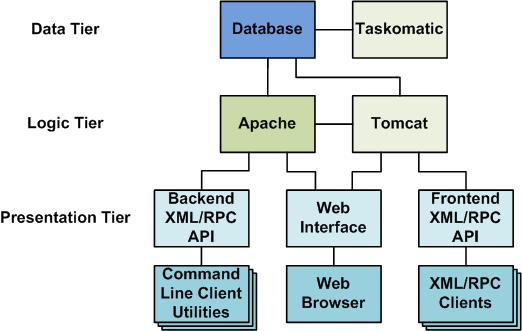The software described in this documentation is either no longer supported or is in extended support.
Oracle recommends that you upgrade to a current supported release.
Chapter 3 Overview of the Spacewalk Architecture
The following figure shows an overview of the internal, three-tier Spacewalk Server architecture.

The server architecture includes the following three tiers:
-
Data tier – Contains the database and Taskomatic. Spacewalk uses the Taskomatic daemon to perform asynchronous scheduled tasks, such as resynchronizing software channels, applying software and configuration updates to clients, and notifying you when new errata become available.
-
Logic tier – Contains the Apache and Tomcat web servers, which process data for use by the presentation tier.
-
Presentation tier – Contains the back-end and front-end XML/RPC APIs, which provide programming interfaces for the command-line client utilities and other XML/RPC clients, and the web interface, which can be accessed by using a web browser.
Spacewalk uses a distributed client-server architecture, in which registered client systems subscribe to the software channels that a Spacewalk server hosts. You can distribute server functionality across as many systems as you require to meet your organization's needs. This capability is especially useful for organizations that are distributed across several geographical regions.
For example, a simple deployment might have a single master or primary server to serve a pool of client systems, along with a proxy server to offload processing from the primary server so that you can support more client systems. In larger deployments, you can configure multiple Spacewalk primary servers and proxy servers to speed up provisioning and software download speeds. In a distributed configuration, clients are likely to have higher network bandwidth access to servers that are within close proximity.
Because the Spacewalk architecture is flexible and scalable, many different deployment configurations are feasible. The following scenarios, which are also illustrated in Figure 3.2, “Example Deployment Configurations for Spacewalk”, are possible:
-
Simple deployment with a single Spacewalk server that has several clients.
-
More complex deployment with one Spacewalk server and two Spacewalk proxies, where each proxy has several clients.
-
Deployment with two Spacewalk servers, each at different sites. The Spacewalk server at one site acts as the primary server, while the Spacewalk server at the other site acts as a worker (slave) server. Inter-Server Synchronization (ISS) is used to manage channel content, channel permissions, and organizational trust settings between the two servers.
Oracle consultants can help your organization design an optimal Spacewalk solution, especially if you need to manage a large, geographically dispersed environment of client systems and servers.
You register client systems, whether physical servers or virtual guests, with a Spacewalk Server Proxy to subscribe them to software channels. The clients can then obtain packages from the Spacewalk server. You can also use Spacewalk with kickstart to automate an Oracle Linux installation by using software packages from a network installation server. If you use Spacewalk with kickstart to provision new client systems, you can configure the Spacewalk server to automatically register these client systems. A new client system is automatically registered as a Spacewalk client if you have associated an activation key with its kickstart profile and configured kickstart to install the Spacewalk Client software on the system.
You can register Oracle Linux 7 Update 1 and later and Oracle Linux 6 Update 9 or later systems without first installing the Spacewalk client software. However, Oracle recommends installing the client software to obtain full Spacewalk client management capabilities.
You can use Spacewalk to administer a registered kickstarted system right away, which simplifies subsequent patching, configuration management, and security auditing. You can also register previously installed legacy systems with a Spacewalk server to bring these systems under Spacewalk control.
